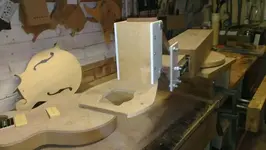@ JCH.. A few pics of the binding jig.. This one I built quite a few years back based on a design by Don Williams.
The jig has two beams made from 1" ply that run inside each other fixed with a heavy duty draw runner. The ones I use are sold for filing cabinets and designed to carry quite a load. You'll need sturdy hinges as the thing has to run effortlessly and without any wobble. They also need to extend almost fully to give you the reach you need.
The jig assembled..

The jig extended...

The beams are fixed to a solid base that has a turntable on it to allow the beam arm to swing side to side. The net result is that the jig will now move all directions on the x axis simultaneously and freely. In,out and side to side.
The turntable needs to be solid also and I tried a few and ended up breaking down a lazy susan to extract the bearings and made my own plates. Much more solid.
Hopefully these pics are self explanatory. The plates are made from mdf with a routed channel in them to take the bearings.



Finally the up/ down motion is accomplished with a simple trapezoid arrangement on the head. The router is fixed to the plate and can now ride up and down without tilting.. The bolts are just snug fit so it holds together but allows the thing to move with little effort.


Last but not least the router base needs a dome shaped base so it can ride along the edge of the instrument without snagging on the arch of the top. A simple dome shaped top hat attachment does this..
Seen from below..

You'll find many examples of this jig on line if you search around. Made this one in about half a day and it has been used dozens of times and has never failed on me.









 .
.